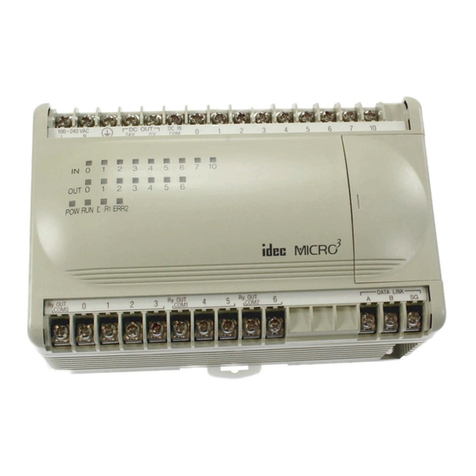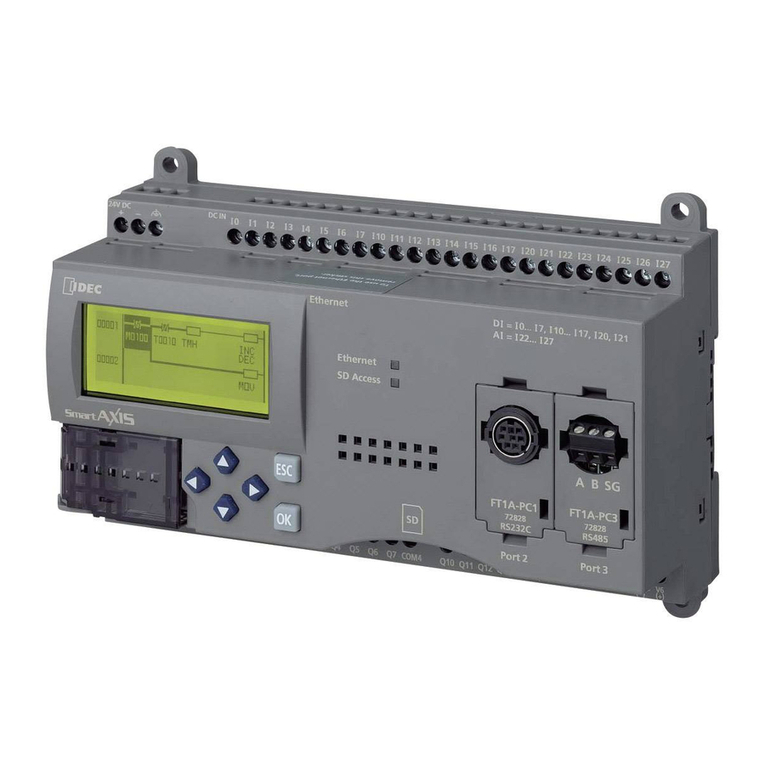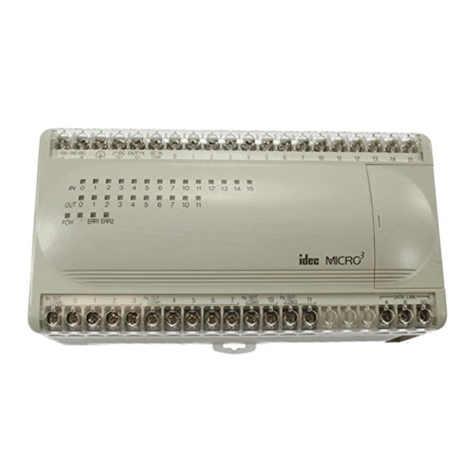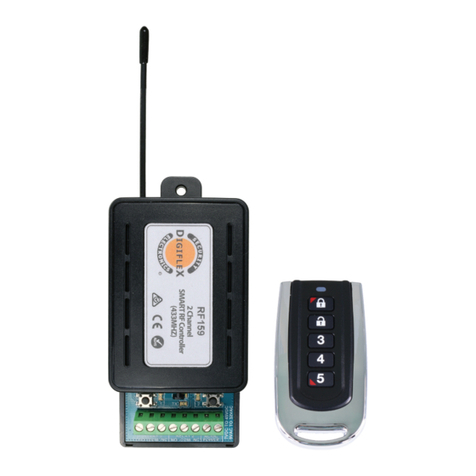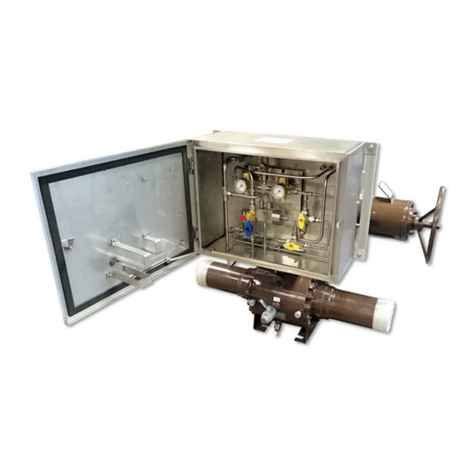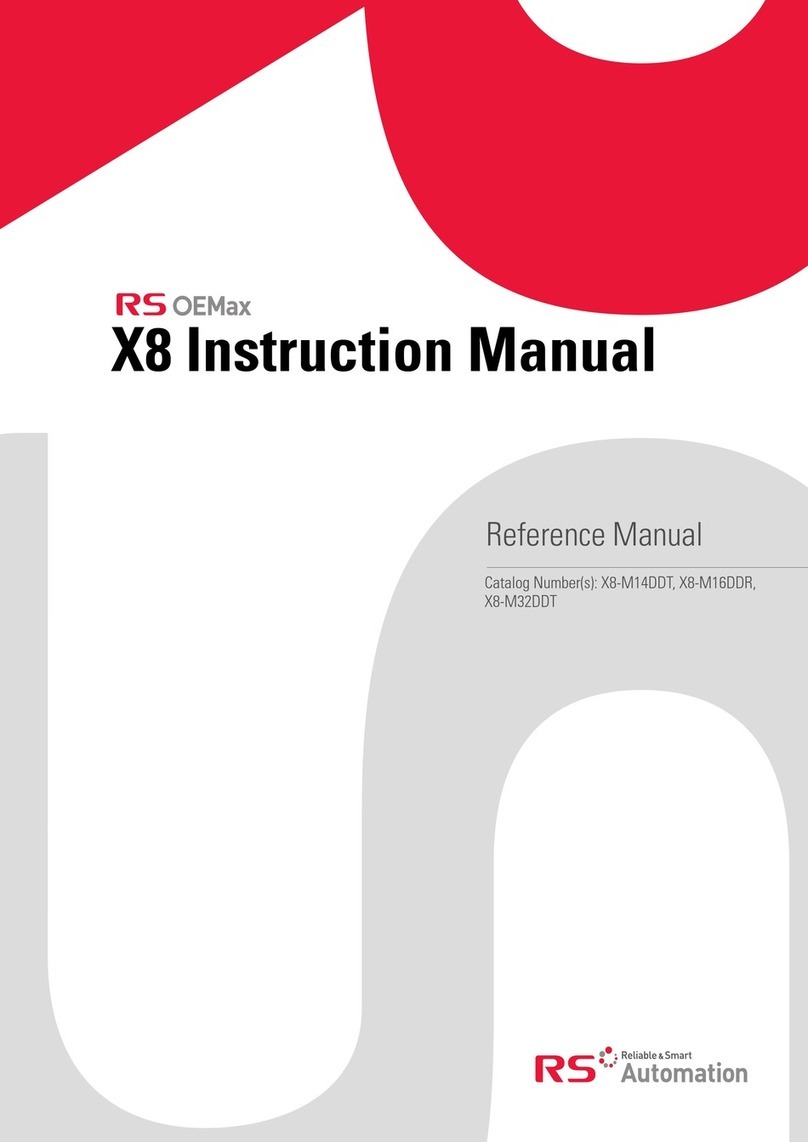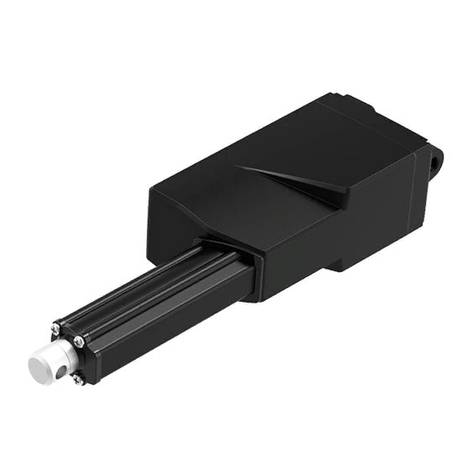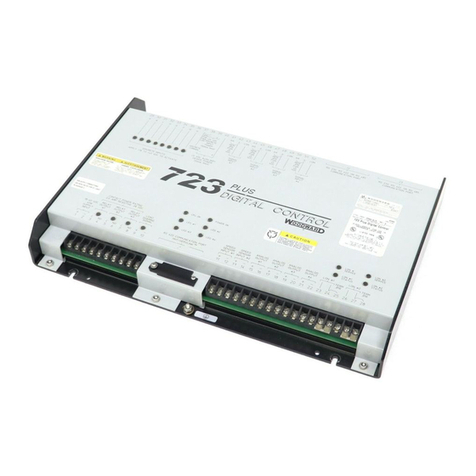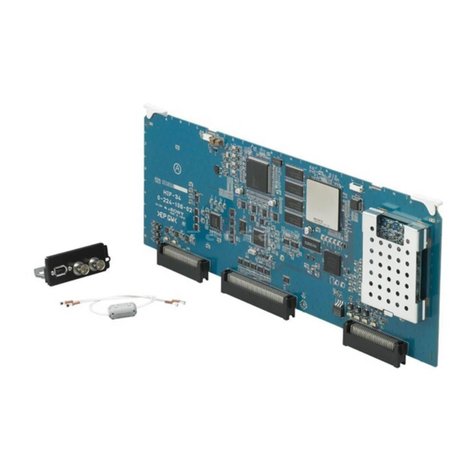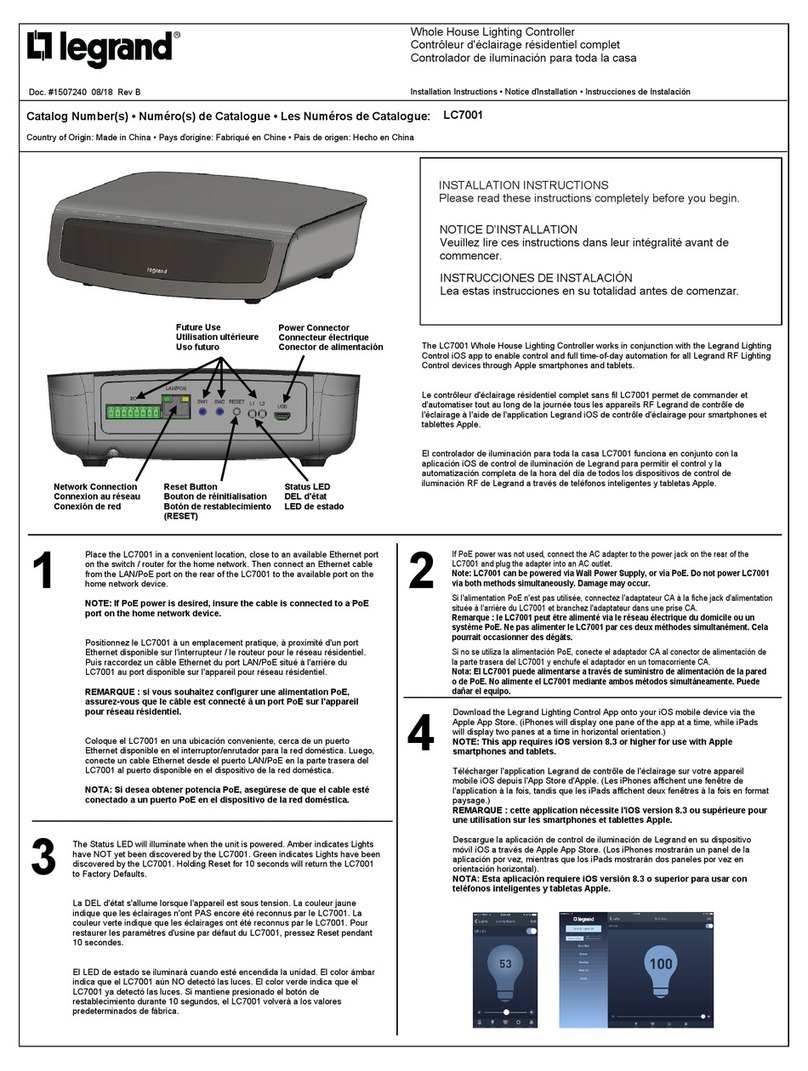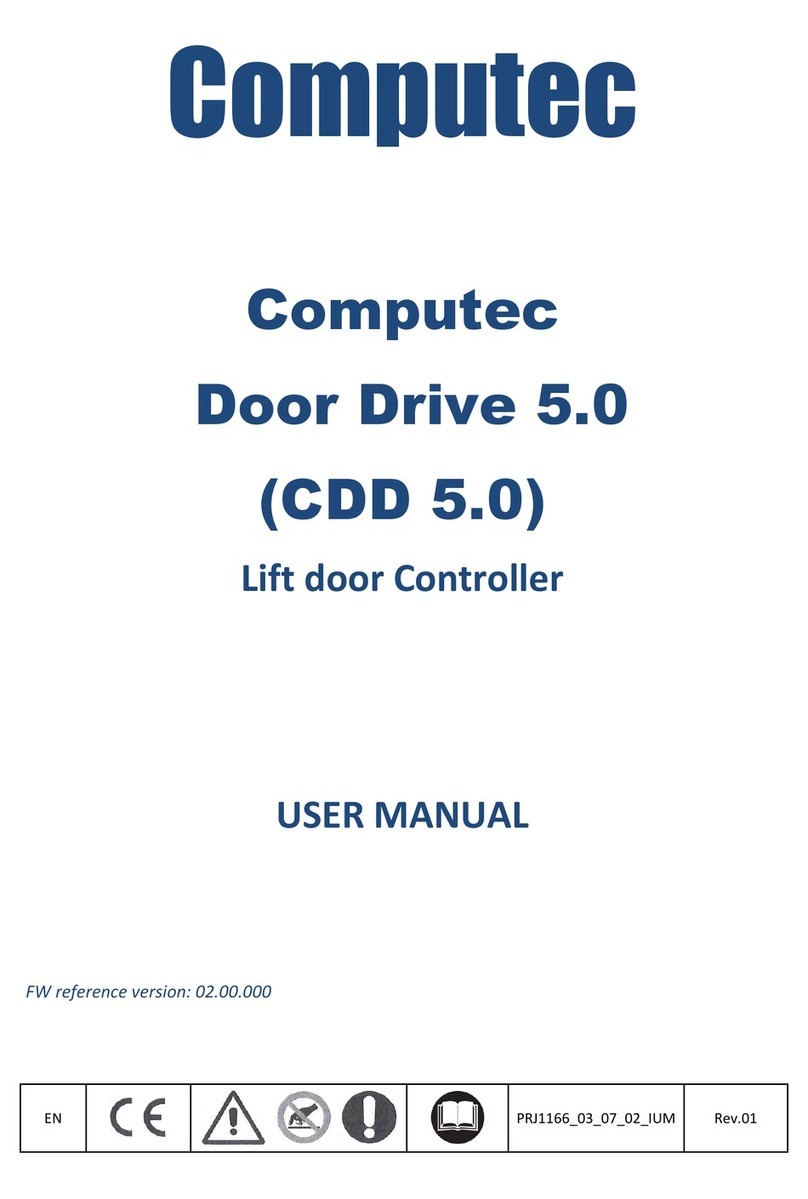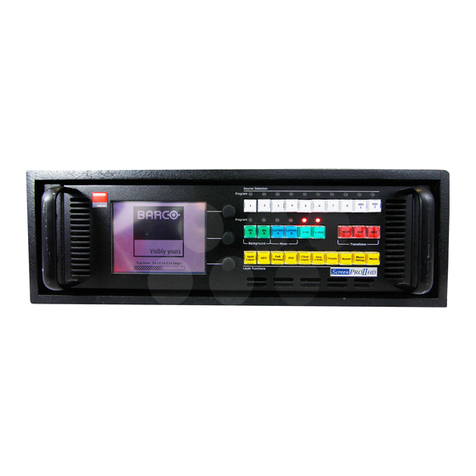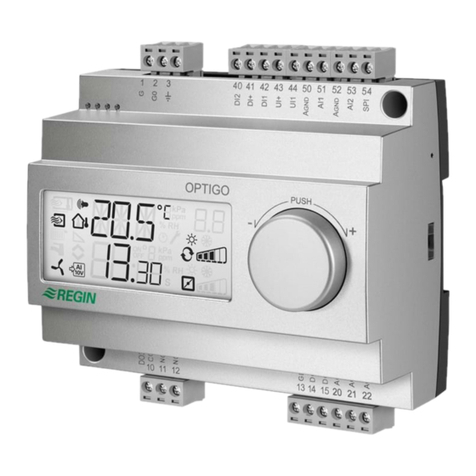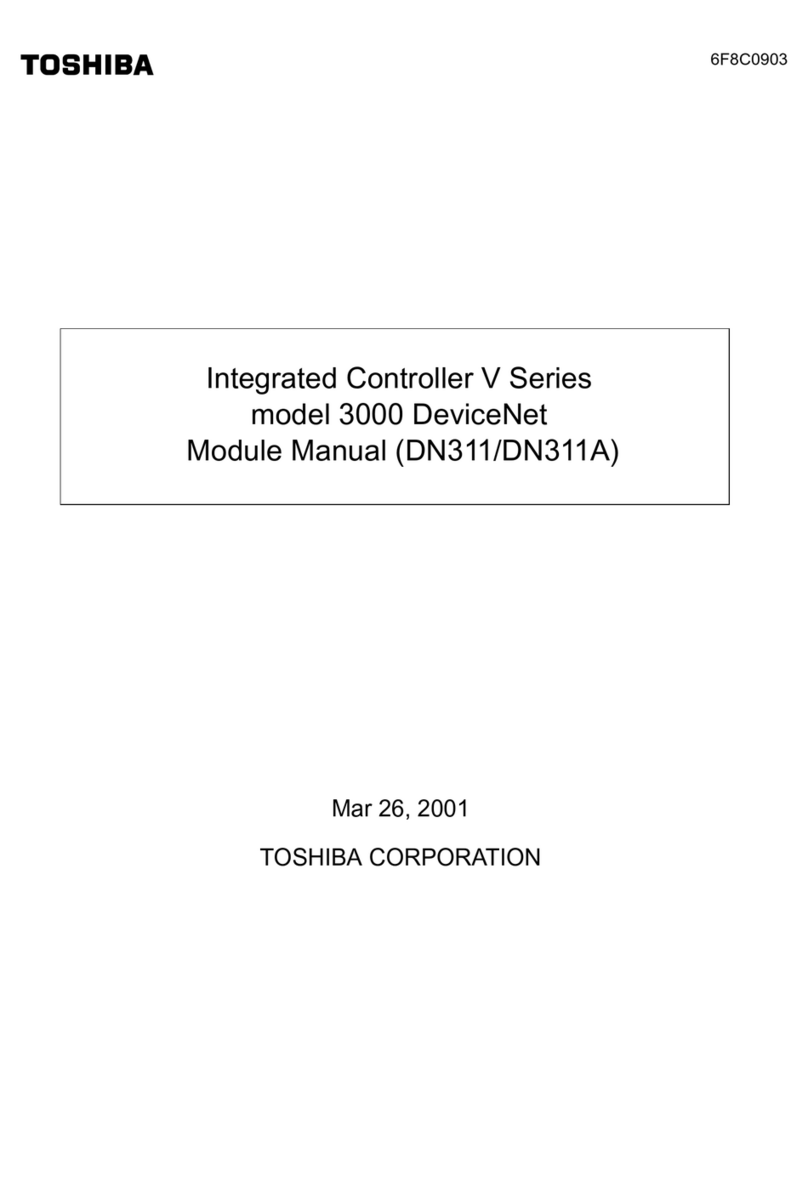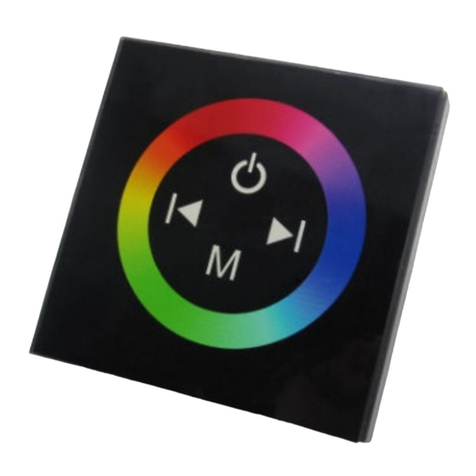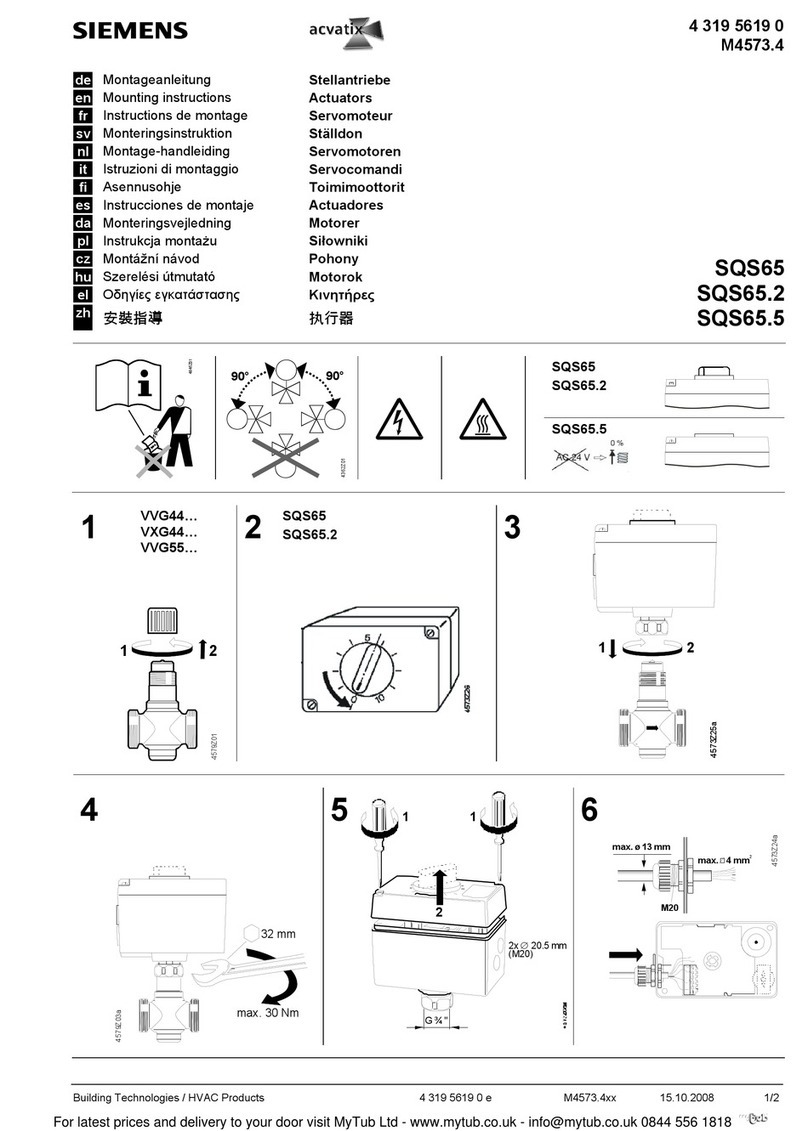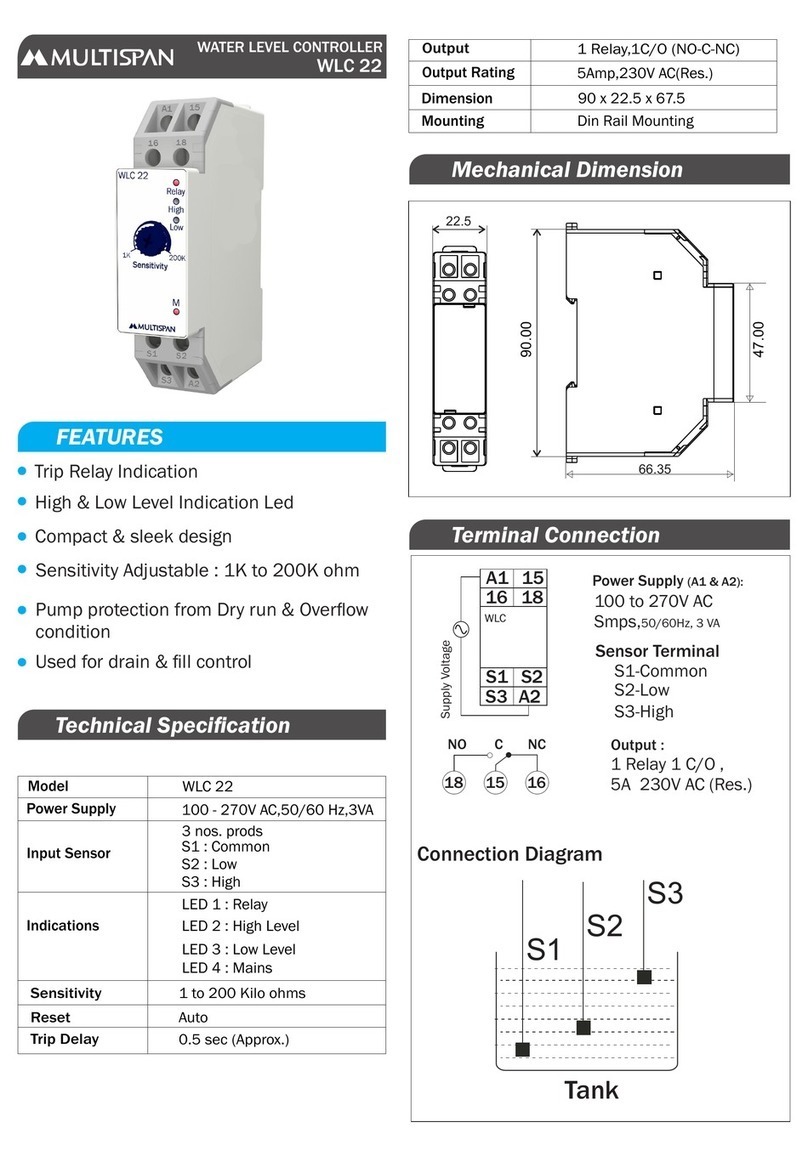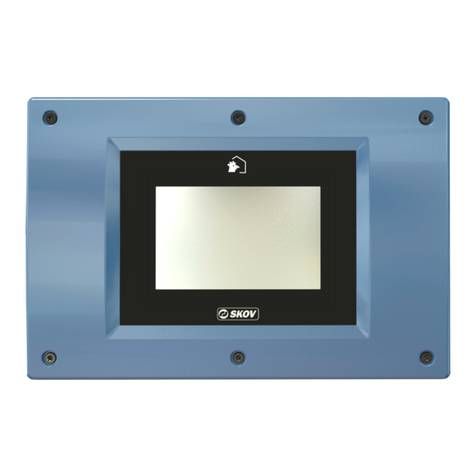IDEC SmartAXIS Touch FT1A Series User manual

FT9Y-B1378(5)


S
MART
AXIS P
RO
/L
ITE
U
SER
'
S
M
ANUAL
FT9Y-B1378 Preface-1
SAFETY PRECAUTIONS
•Read the SmartAXIS Pro/Lite User’s Manual to ensure correct operation before starting installation, wiring, operation, maintenance, and
inspection of the SmartAXIS.
•All SmartAXIS modules are manufactured under IDEC’s rigorous quality control system, but users must add a backup or failsafe provision to the
control system when using the SmartAXIS in applications where heavy damage or personal injury may be caused, in case the SmartAXIS should
fail.
•In this user’s manual, safety precautions are categorized in order of importance:
•The SmartAXIS is not designed for use in medical equipment, nuclear power, railways, aviation, passenger vehicle equipment, or similar
applications requiring a high degree of reliability and safety. The SmartAXIS should not be used for such applications.
•When using the SmartAXIS in applications (not described above) that require a high degree of reliability in terms of functionality and precision,
appropriate measures such as failsafe mechanisms and redundant mechanisms must be taken for the system containing the SmartAXIS.
•Emergency stop and interlocking circuits must be configured outside the SmartAXIS.
•If relays or transistors in the SmartAXIS output circuits should fail, outputs may remain at on or off state. For output signals which may cause
serious accidents, configure monitor circuits outside the SmartAXIS.
•The SmartAXIS self-diagnostic function may detect internal circuit or program errors, stop programs, and turn outputs off. Configure circuits
so that the system containing the SmartAXIS is not jeopardized when outputs turn off.
•Turn off power to the SmartAXIS before installation, removal, wiring, maintenance, and inspection of the SmartAXIS. Failure to turn power off
may cause electrical shocks or fire hazard.
•Special expertise is required to install, wire, program, and operate the SmartAXIS. People without such expertise must not use the SmartAXIS.
•Install the SmartAXIS according to the instructions described in SmartAXIS Pro/Lite user's manual. Improper installation will result in falling,
failure, or malfunction of the SmartAXIS.
•The SmartAXIS is designed for installation in a cabinet. Do not install the SmartAXIS outside a cabinet.
•Install the SmartAXIS in environments described in the SmartAXIS Pro/Lite user's manual. If the SmartAXIS is used in places where the
SmartAXIS is subjected to high-temperature, high-humidity, condensation, corrosive gases, excessive vibrations, or excessive shocks, then
electrical shocks, fire hazard, or malfunction will result.
•The environment for using the SmartAXIS is “Pollution degree 2.” Use the SmartAXIS in environments of pollution degree 2 (according to IEC
60664-1).
•Prevent the SmartAXIS from falling while moving or transporting the SmartAXIS, otherwise damage or malfunction of the SmartAXIS will result.
•Wiring must use lead sizes that are appropriate for the applied voltage and current. Terminal screws must be tightened with the prescribed
tightening torque.
•Prevent metal fragments and pieces of wire from dropping inside the SmartAXIS housing. Put a cover on the SmartAXIS modules during
installation and wiring. Ingress of such fragments and chips may cause fire hazard, damage, or malfunction.
•Use a power supply of the rated value. Use of a wrong power supply may cause fire hazard.
•Use an IEC 60127-approved fuse on the power line outside the SmartAXIS. This is required when equipment containing the SmartAXIS is
destined for Europe.
•Use an IEC 60127-approved fuse on the output circuit. This is required when equipment containing the SmartAXIS is destined for Europe.
•Use an EU-approved circuit breaker. This is required when equipment containing the SmartAXIS is destined for Europe.
•Make sure of safety before starting and stopping the SmartAXIS or when operating the SmartAXIS to force outputs on or off. Incorrect operation
of the SmartAXIS may cause machine damage or accidents.
•Do not connect the ground wire directly to the SmartAXIS. Connect a protective ground to the cabinet containing the SmartAXIS using an M4 or
larger screw. This is required when equipment containing the SmartAXIS is destined for Europe.
•Do not disassemble, repair, or modify the SmartAXIS modules.
•The SmartAXIS contains electronic parts and batteries. When disposing of the SmartAXIS, do so in accordance
with national and local regulations.
Warning notices are used to emphasize that improper operation may cause severe personal injury or death.
Warning
Caution notices are used where inattention might cause personal injury or damage to equipment.
Caution

Preface-2 S
MART
AXIS P
RO
/L
ITE
U
SER
'
S
M
ANUAL
FT9Y-B1378
ABOUT THIS MANUAL
This user’s manual describes functions, specifications, installation, and operation basics of the SmartAXIS. Also included is
information on the powerful communications tools of the SmartAXIS, as well as troubleshooting procedures.
Chapter 1: General Information
General information about the SmartAXIS, features, brief description on special functions, and various system setup configurations
for communication.
Chapter 2: Product Specifications
Specifications of SmartAXIS, optional adapters, and cartridges.
Chapter 3: Installation and Wiring
Methods and precautions for installing and wiring the SmartAXIS.
Chapter 4: Operation Basics
General information about setting up the basic SmartAXIS system for programming, starting and stopping SmartAXIS operation, and simple
operating procedures. Everything from creating a user program using WindLDR on a computer to monitoring the SmartAXIS operation.
Chapter 5: Special Functions
Stop/reset inputs, run/stop selection at memory backup error, and keep designation. Also included are high-speed counter,
frequency measurement, catch input, interrupt input, timer interrupt, input filter, user program protection, daylight savings time,
network settings, and many more special functions.
Chapter 6: HMI Function
HMI function on the SmartAXIS Pro by using the LCD and operation buttons on the SmartAXIS.
Chapter 7: Device Addresses
Device addresses available for the SmartAXIS to program basic and advanced instructions. Special internal relays and special data
registers are also described.
Chapter 8: Instructions Reference
List of basic and advanced instructions to program the SmartAXIS.
Chapter 9 through Chapter 11: Maintenance Communication, User Communication Instructions, Modbus
Communication
Various communication functions such as user communication and Modbus communication.
Chapter 12: Remote I/O
Remote I/O communication to increase the number of inputs and outputs by connecting other SmartAXIS as remote I/O slaves over Ethernet.
Chapter 13: Script
Programming complicated processing with script language using conditional branching, logical operations, arithmetic operations, and functions.
Chapter 14: Troubleshooting
Procedures to determine the cause of trouble and actions to be taken when any trouble occurs while operating the SmartAXIS.
Appendix
Additional information about type numbers, system software upgrade, and USB driver installation.
Index
Alphabetical listing of key words.
Publication history
Trademarks
SmartAXIS is a trademark of IDEC Corporation.
Regarding laws and compatible standards
This product adheres to the laws and compatible standards of all countries involved, as shown below.
European laws and standards
This product complies with the following EU directives.
•Low Voltage Directive (Directive 2006/95/EC)
•EMC Directive (Directive 2004/108/EC)
To comply with these directives, this product has been designed and evaluated on the basis of the following international and
European standard.
•IEC/EN 61131-2: 2007 (excluding the Lite digital I/O status indicators)
For details on the compatible standards and EU Directives, contact the distributor from which you purchased this product or visit our web site.
North America laws and standards
This product complies with the following standards.
•UL508
•CSA C22.2 No.14
Marine standards
This product is certified by the following classification societies. (FT1A Version V130 or later, system software version V2.10 or
later)
- ABS (American Bureau of Shipping)
- DNV (Det Norske Veritas, Norwegian classification society)
- LR (Lloyd's Register)
- NK (Nippon Kaiji Kyokai)
•To use this product as a marine certified product, wrap the power supply cable (excluding the earth wire) and the Ethernet communication cable
connected to the SmartAXIS around a ferrite core (TDK ZCAT3035-1330) twice.
•Wrap cables connected to the communication cartridge around a ferrite core (TDK ZCAT1730-0730) twice.
•This product is not certified for use on the bridge and deck.
March 2013 First Edition
August 2013 Second Edition
October 2013 Third Edition
December 2013 Fourth Edition
August 2014 Fifth Edition
May 2019 Sixth Edition

S
MART
AXIS P
RO
/L
ITE
U
SER
'
S
M
ANUAL
FT9Y-B1378 Preface-3
IMPORTANT INFORMATION
Under no circumstances shall IDEC Corporation be held liable or responsible for indirect or consequential damages resulting from
the use of or the application of IDEC PLC components, individually or in combination with other equipment.
All persons using these components must be willing to accept responsibility for choosing the correct component to suit their
application and for choosing an application appropriate for the component, individually or in combination with other equipment.
All diagrams and examples in this manual are for illustrative purposes only. In no way does including these diagrams and
examples in this manual constitute a guarantee as to their suitability for any specific application. To test and approve all
programs, prior to installation, is the responsibility of the end user.

Preface-4 S
MART
AXIS P
RO
/L
ITE
U
SER
'
S
M
ANUAL
FT9Y-B1378
RELATED MANUALS
The following manuals related to the SmartAXIS are available. Refer to them in conjunction with this manual.
Type No. Manual Name Description
FT9Y-B1378 SmartAXIS Pro/Lite
User’s Manual (this manual)
Describes product specifications, installation and wiring instructions, instructions for
basic programming operations and special functions, device and instruction lists,
communication functions, and troubleshooting procedures for the SmartAXIS Pro/
Lite series.
FT9Y-B1382 SmartAXIS
Ladder Programming Manual
Describes basic operations for ladder programming, instructions for monitoring
ladders on the SmartAXIS, available devices and instruction lists, and details of each
instruction.
FT9Y-B1386 SmartAXIS
FBD Programming Manual Describes basic operations for function block programming, available devices and
function block lists, and details of each function block.
FT9Y-B1390 SmartAXIS Touch
User’s Manual
Describes product specifications, installation and wiring instructions, instructions for
setting basic programming actions and special functions, device and instruction lists,
communication functions, and troubleshooting procedures for the Touch series.
WindLDR Help Describes usage instructions for WindLDR, programming software for the SmartAXIS
Pro/Lite series.
WindO/I-NV3 Help Describes programming for the SmartAXIS Touch series, and usage instructions for
the WindO/I-NV3 configuration software.

S
MART
AXIS P
RO
/L
ITE
U
SER
'
S
M
ANUAL
FT9Y-B1378 Preface-5
NAMES AND ABBREVIATIONS USED IN THIS MANUAL
Model Names
Abbreviations
Name Used in this Manual Description (Detailed Type No.)
SmartAXIS Name for the FT1A programmable logic controllers.
SmartAXIS Lite Modules without LCD.
(FT1A-B12RA, FT1A-B12RC, FT1A-B24RA, FT1A-B24RC, FT1A-B40RKA, FT1A-B40RSA, FT1A-B40RC,
FT1A-B48KA, FT1A-B48SA, FT1A-B48KC, FT1A-B48SC)
SmartAXIS Pro Modules with LCD.
(FT1A-H12RA, FT1A-H12RC, FT1A-H24RA, FT1A-H24RC, FT1A-H40RKA, FT1A-H40RSA, FT1A-H40RC,
FT1A-H48KA, FT1A-H48SA, FT1A-H48KC, FT1A-H48SC)
SmartAXIS Touch
Modules that extend the functionality of display.
(FT1A-M12RA-W, FT1A-M12RA-B, FT1A-M12RA-S, FT1A-C12RA-W, FT1A-C12RA-B, FT1A-C12RA-S,
FT1A-M14KA-W, FT1A-M14KA-B, FT1A-M14KA-S, FT1A-M14SA-W, FT1A-M14SA-B, FT1A-M14SA-S,
FT1A-C14KA-W, FT1A-C14KA-B, FT1A-C14KA-S, FT1A-C14SA-W, FT1A-C14SA-B, FT1A-C14SA-S)
12-I/O type SmartAXIS Pro and Lite models with 12 I/O points.
(FT1A-B12RA, FT1A-B12RC, FT1A-H12RA, FT1A-H12RC)
24-I/O type SmartAXIS Pro and Lite models with 24 I/O points.
(FT1A-B24RA, FT1A-B24RC, FT1A-H24RA, FT1A-H24RC)
40-I/O type SmartAXIS Pro and Lite models with 40 I/O points.
(FT1A-B40RKA, FT1A-B40RSA, FT1A-B40RC, FT1A-H40RKA, FT1A-H40RSA, FT1A-H40RC)
48-I/O type SmartAXIS Pro and Lite models with 48 I/O points.
(FT1A-B48KA, FT1A-B48SA, FT1A-B48KC, FT1A-B48SC, FT1A-H48KA, FT1A-H48SA, FT1A-H48KC,
FT1A-H48SC)
AC power type SmartAXIS Pro and Lite models with an AC power supply.
(FT1A-B12RC, FT1A-H12RC, FT1A-B24RC, FT1A-H24RC, FT1A-B40RC, FT1A-H40RC, FT1A-B48KC,
FT1A-B48SC, FT1A-H48KC, FT1A-H48SC)
DC power type SmartAXIS Pro and Lite models with a DC power supply.
(FT1A-B12RA, FT1A-H12RA, FT1A-B24RA, FT1A-H24RA, FT1A-B40RKA, FT1A-H40RKA,
FT1A-B40RSA, FT1A-H40RSA, FT1A-B48KA, FT1A-B48SA, FT1A-H48KA, FT1A-H48SA)
Abbreviation Meaning
FBD Function block diagram
FB Function block
For example, the AND (logical AND) function block is written as AND FB.

IFT1A SmartA
XIS
Pro/Lite User’s Manual FT9Y-B1378
TABLE OF CONTENTS
Safety Precautions ............................................................................................................................ Preface-1
About This Manual............................................................................................................................ Preface-2
Related Manuals ............................................................................................................................... Preface-4
Names and Abbreviations Used in this Manual..................................................................................... Preface-5
CHAPTER
1: General Information
About the SmartAXIS .................................................................................................................................. 1-1
Features..................................................................................................................................................... 1-3
Special Functions........................................................................................................................................ 1-4
Communication Functions............................................................................................................................ 1-6
Maintenance Communication ....................................................................................................................... 1-7
User Communication................................................................................................................................... 1-8
Modbus Communication .............................................................................................................................. 1-8
Remote I/O................................................................................................................................................ 1-9
Ethernet Communication ............................................................................................................................. 1-9
Operator Interface Connectivity ..................................................................................................................1-10
CHAPTER
2: Product Specifications
Parts Description......................................................................................................................................... 2-1
Communication Cartridge ...........................................................................................................................2-23
Memory Cartridge......................................................................................................................................2-25
Ethernet Port.............................................................................................................................................2-27
SD Memory Card........................................................................................................................................2-28
Dimensions................................................................................................................................................2-30
CHAPTER
3: Installation and Wiring
Installation Location.................................................................................................................................... 3-1
Mounting Space.......................................................................................................................................... 3-2
Mounting on DIN Rail.................................................................................................................................. 3-3
Removing from DIN Rail.............................................................................................................................. 3-3
Direct Mounting on Panel Surface................................................................................................................. 3-4
Input/Output Wiring.................................................................................................................................... 3-7
Power Supply ............................................................................................................................................3-11
Terminal Connection ..................................................................................................................................3-13
Securing the Panel Attachment USB Extension Cable ....................................................................................3-14
CHAPTER
4: Operation Basics
Start WindLDR............................................................................................................................................ 4-1
PLC Selection.............................................................................................................................................. 4-2
Create Program .......................................................................................................................................... 4-3
Convert Program........................................................................................................................................4-11
Save Project..............................................................................................................................................4-11
Simulate Operation ....................................................................................................................................4-12
Download Program ....................................................................................................................................4-14
Monitor Operation......................................................................................................................................4-15
Exit WindLDR ............................................................................................................................................4-16
Start/Stop Operation..................................................................................................................................4-17
CHAPTER
5: Special Functions
Function Area Settings ................................................................................................................................ 5-2
Stop Input and Reset Input ......................................................................................................................... 5-4
Run/Stop Selection at Memory Backup Error ................................................................................................. 5-5
Run/Stop Selection at Power Up................................................................................................................... 5-6
Keep Designation for Internal Relays, Shift Registers, Counters, and Data Registers ........................................ 5-7
Data Register ROM Backup.......................................................................................................................... 5-9
High-Speed Counter...................................................................................................................................5-13
Catch Input...............................................................................................................................................5-32
Interrupt Input ..........................................................................................................................................5-34
Frequency Measurement ............................................................................................................................5-36
Input Filter................................................................................................................................................5-38

S
MART
AXIS P
RO
/L
ITE
U
SER
'
S
M
ANUAL
FT9Y-B1378 II
T
ABLE
OF
C
ONTENTS
Analog Input.............................................................................................................................................5-39
Timer Interrupt .........................................................................................................................................5-41
Forced I/O function ...................................................................................................................................5-43
Communication Ports.................................................................................................................................5-46
Memory Cartridge......................................................................................................................................5-49
SD Memory Card.......................................................................................................................................5-52
Backlight ON Time.....................................................................................................................................5-57
Monitoring Ladder Program........................................................................................................................5-58
Message Settings ......................................................................................................................................5-60
32-bit Data Storage Setting........................................................................................................................5-62
User Program Protection............................................................................................................................5-64
Watchdog Timer Setting ............................................................................................................................5-66
Constant Scan Time...................................................................................................................................5-67
Daylight Savings Time ...............................................................................................................................5-68
Clock Function...........................................................................................................................................5-69
Network Settings.......................................................................................................................................5-72
Connection Settings...................................................................................................................................5-73
Remote Host List.......................................................................................................................................5-75
CHAPTER
6: HMI Function
About the Menu Screen................................................................................................................................6-2
Basic Operations .........................................................................................................................................6-3
Switching to the System Menu .....................................................................................................................6-6
Switching run/stop ......................................................................................................................................6-7
SmartAXIS Environment Settings..................................................................................................................6-8
Monitoring the SmartAXIS..........................................................................................................................6-15
Checking/Clearing Error Information...........................................................................................................6-20
Uploading/Downloading the User Program ..................................................................................................6-22
Displaying Arbitrary Messages ....................................................................................................................6-24
Maintaining the SD Memory Card................................................................................................................6-25
Entering a Password..................................................................................................................................6-27
System Menu Hierarchy Diagram................................................................................................................6-28
CHAPTER
7: Device Addresses
Device Addresses ........................................................................................................................................7-1
Special Internal Relays.................................................................................................................................7-2
Special Data Registers .................................................................................................................................7-8
CHAPTER
8: Instructions/Function Blocks Reference
Ladder Program Instructions List ..................................................................................................................8-1
Advanced Instruction List.............................................................................................................................8-3
Advanced Instruction Applicable SmartAXIS ..................................................................................................8-6
FB List........................................................................................................................................................8-9
CHAPTER
9: Maintenance Communication
Maintenance Communication via USB Port.....................................................................................................9-2
Maintenance Communication via Expansion Communication Port ....................................................................9-3
Maintenance Communication via Ethernet Port ..............................................................................................9-5
CHAPTER
10: User Communication Instructions
User Communication via Serial Communication............................................................................................10-1
User Communication Overview...................................................................................................................10-1
User Communication Mode Specifications....................................................................................................10-1
RS232C User Communication System Setup ................................................................................................10-2
RS485 User Communication System Setup ..................................................................................................10-3
Programming WindLDR..............................................................................................................................10-4
RS232C Line Control Signals..................................................................................................................... 10-11
User Communication via Ethernet Communication ..................................................................................... 10-14
Ethernet User Communication Overview.................................................................................................... 10-14
User Communication Client ...................................................................................................................... 10-16

T
ABLE
OF
C
ONTENTS
III S
MART
AXIS P
RO
/L
ITE
U
SER
'
S
M
ANUAL
FT9Y-B1378
User Communication Server......................................................................................................................10-19
Programming WindLDR (User Communication Server) ................................................................................10-20
User Communication Error........................................................................................................................10-22
ASCII Character Code Table .....................................................................................................................10-23
Sample Program – User Communication TXD.............................................................................................10-24
Sample Program – User Communication RXD.............................................................................................10-26
CHAPTER
11: Modbus Communication
Modbus Communication via RS-232C/RS-485...............................................................................................11-1
Modbus Master Communication...................................................................................................................11-2
Modbus Slave Communication.....................................................................................................................11-8
Communication Format ............................................................................................................................11-12
Modbus Communication via Ethernet Communication .................................................................................11-18
Modbus TCP Client...................................................................................................................................11-19
Modbus TCP Server..................................................................................................................................11-24
CHAPTER
12: Remote I/O
Remote I/O Master ....................................................................................................................................12-2
Remote I/O Slave ......................................................................................................................................12-8
CHAPTER
13: Scripts
Script Programming and Management.........................................................................................................13-3
Programming Scripts................................................................................................................................13-10
Script Programming Examples...................................................................................................................13-16
Important Notes ......................................................................................................................................13-35
About the Priority of the Operator.............................................................................................................13-35
CHAPTER
14: Troubleshooting
Reading Error Data ....................................................................................................................................14-1
Special Data Registers for Error Information ................................................................................................14-3
General Error Codes...................................................................................................................................14-3
SmartAXIS Operating Status, Output, and ERR LED during Errors..................................................................14-4
Error Causes and Actions............................................................................................................................14-4
User Program Execution Error.....................................................................................................................14-6
Troubleshooting Diagrams..........................................................................................................................14-7
APPENDIX
System Software......................................................................................................................................... A-1
USB Driver Installation Procedure................................................................................................................. A-5
Cables........................................................................................................................................................ A-8
HMI Screen Transition Diagram.................................................................................................................. A-11
Type List.................................................................................................................................................. A-15
Fonts ....................................................................................................................................................... A-17
INDEX

S
MART
AXIS P
RO
/L
ITE
U
SER
'
S
M
ANUAL
FT9Y-B1378 1-1
1: GENERAL INFORMATION
Introduction
This chapter describes SmartAXIS functions and system configuration examples. The SmartAXIS is available in three types: the
SmartAXIS Lite, the SmartAXIS Pro, and the SmartAXIS Touch. The SmartAXIS Lite is equipped with the same various control and
communication functions as a PLC. In addition to the functions of the SmartAXIS Lite, the SmartAXIS Pro is equipped with an LCD
and operation buttons on the front of the module. The SmartAXIS Touch is equipped with the HMI functions of an operator
interface and PLC control functions.
This document describes the SmartAXIS Lite and Pro. Unless otherwise specified, SmartAXIS refers to the SmartAXIS Lite and Pro.
For the SmartAXIS Touch, refer to the SmartAXIS Touch User's Manual.
About the SmartAXIS
The SmartAXIS is a small-size programmable controller that is fully equipped with powerful functions and various communication
functions.
You can select the type of SmartAXIS best-suited for your applications, in such ways as the inclusion of the display function, the
type of power supply, and the number of inputs and outputs.
The SmartAXIS Lite is equipped with basic functions. The SmartAXIS Pro adds to the functionality of the SmartAXIS Lite and is
equipped with an LCD and operation buttons on the module, enabling independent monitor and operation functions.
The SmartAXIS supports 100 to 240V AC and 24V DC power supplies. SmartAXIS with Ethernet port (24-, 40-, 48-I/O types) can
expand the number of inputs and outputs for a maximum of 90 inputs and a maximum of 54 outputs using the remote I/O
function.
User programs can be created using WindLDR, the PLC programming software.
The SmartAXIS supports ladder programs and function block programs. Ladder programs for FT1A are compatible with other IDEC
PLCs including MicroSmart and MicroSmart Pentra, so you can make use of existing software assets.
Type Numbers
The notation for SmartAXIS part numbers is as follows.
Note: For the input specifications, see "Input Specifications (AC Power Type)" on page 2-8 to "Input Specifications (DC Power Type)" on page 2-10.
Power supply type A: DC power type (24V DC)
C: AC power type (100 to 240V AC)
tuptuoyaleR:RepyttuptuO
RK: Relay output/transistor sink output
RS: Relay output/transistor source output
K: Transistor sink output
S: Transistor source output
stniopO/I21:21stuptuo/stupnI
24: 24 I/O points
40: 40 I/O points
48: 48 I/O points
H: With LCD and operation buttons B: Without LCD and operation buttons
FT1A: Type number
FT1A - H 12 R A

1: G
ENERAL
I
NFORMATION
1-2 S
MART
AXIS P
RO
/L
ITE
U
SER
'
S
M
ANUAL
FT9Y-B1378
Type List
Options
Type Number Power Supply
Inputs and
Outputs
(In/Out)
LCD,
Operation
Buttons
USB Port
Expansion
Communication
Port
Ethernet
Port
SD Memory
Card slot
FT1A-H12RA 24V DC
12 (8/4) Yes
Yes
——
—
FT1A-H12RC 100 to 240V AC
FT1A-B12RA 24V DC —
FT1A-B12RC 100 to 240V AC
FT1A-H24RA 24V DC
24 (16/8) Yes Yes
1 port
Yes
FT1A-H24RC 100 to 240V AC
FT1A-B24RA 24V DC —
FT1A-B24RC 100 to 240V AC
FT1A-H40RKA 24V DC
40 (24/16)
Yes
Yes
2 ports Yes
FT1A-H40RSA
FT1A-H40RC 100 to 240V AC
FT1A-B40RKA 24V DC —FT1A-B40RSA
FT1A-B40RC 100 to 240V AC
FT1A-H48KA 24V DC
48 (30/18)
Yes
FT1A-H48SA
FT1A-H48KC 100 to 240V AC
FT1A-H48SC
FT1A-B48KA 24V DC —
FT1A-B48SA
FT1A-B48KC 100 to 240V AC
FT1A-B48SC
RS232C Communication Cartridge
FT1A-PC1 (Mini-DIN type)
Memory Cartridge
FT1A-PM1
USB Maintenance Cable
HG9Z-XCM42
SD Memory Card (2GB)
HG9Z-XMS2
RS485 Communication Cartridge
FT1A-PC2 (Mini-DIN type) RS485 Communication Cartridge
FT1A-PC3 (Terminal block type)
Panel Mount USB Extension Cable
HG9Z-XCE21

S
MART
AXIS P
RO
/L
ITE
U
SER
'
S
M
ANUAL
FT9Y-B1378 1-3
1: G
ENERAL
I
NFORMATION
Features
This section describes the features of the SmartAXIS.
The SmartAXIS is high-performance programmable controller in a compact package and is equipped with high speed counters that
can be used for positioning control. The SmartAXIS enables you to build optimum systems to automate factories or control
production lines.
Powerful HMI Functions
The SmartAXIS Pro is equipped with an LCD on the front of the module, enabling you to monitor the device values and the ladder
program. Customized messages can be programmed to display current time, bar charts, scrolling messages, or simple text on the
LCD. The operation buttons on the module are used for operations with LCD such as checking and modifying device values.
Powerful Communication Functions
The SmartAXIS supports various communications such as maintenance communication, user communication, Modbus
communication, and remote I/O.
The SmartAXIS is equipped with RS232C (optional), RS485 (optional), an Ethernet port, and a USB port, and can be connected to
various devices such as computers, operator interfaces, and printers.
Memory Cartridge
A user program of SmartAXIS can be stored in a memory cartridge (FT1A-PM1). When a memory cartridge is inserted into a
SmartAXIS, the user program in the memory cartridge is executed instead of the user program in the SmartAXIS. You can also
download the user program in a memory cartridge to the SmartAXIS.
SD Memory Card
The 40- and 48-I/O types are equipped with an SD memory card slot. The log data of device values can be saved to an optional SD
memory card (HG9Z-XMS2) or a commercially available SD memory card (32 GB maximum).
32-bit and Floating Point Data Types
Some advanced instructions can select 32-bit data types from D (double word), L (long), and F (float) in addition to W (word) and
I (integer).
Safety and High-Quality Compliant with International Standards
The SmartAXIS is compliant with international standards and can be used all over the world while maintaining safety and high
quality.
Supports 9 Languages
The SmartAXIS LCD supports the display of the following nine languages:
Note: Some of the characters cannot be input.
Setting Name Character Set Supported Languages
European ISO 8859-1 (Latin-1) English, German, Italian, Spanish, Dutch (Note), French (Note)
Japanese Shift-JIS Japanese (level 1)
Chinese GB2312 Chinese (simplified)
Cyrillic ANSI 1251 Russian
RS232C Communication Cartridge
FT1A-PC1 (Mini-DIN type) RS485 Communication Cartridge
FT1A-PC2 (Mini-DIN type) RS485 Communication Cartridge
FT1A-PC3 (Terminal block type)
Memory Cartridge
FT1A-PM1

1: G
ENERAL
I
NFORMATION
1-4 S
MART
AXIS P
RO
/L
ITE
U
SER
'
S
M
ANUAL
FT9Y-B1378
Special Functions
This section describes the functions of the SmartAXIS.
I/O Related Functions
Catch Input
The catch input receives short input pulses from sensors without regard to the scan time. A maximum of 6 catch inputs can be
used.
Input Filter
The input filter can be adjusted, according to the width of input signals, to reject input noises. Selectable input filter values to pass
input signals are 0ms, and 3 through 15ms in 1ms increments. The input filter rejects inputs shorter than the selected input filter
value minus 2ms. This function is useful for eliminating input noises and chatter in limit switches.
Interrupt Input
The interrupt input can be used to call an interrupt program to respond to an external input that requires a response faster than
the scan time. A maximum of six interrupt inputs can be used. This can only be used when ladder program is selected as the
programming language.
Stop and Reset Inputs
Stop input is a function to stop SmartAXIS operation. Reset input is a function to stop SmartAXIS operation and clear device
values. Any input terminal on the SmartAXIS can be designated as a stop or reset input to control the SmartAXIS operation.
Remote I/O
When the number of SmartAXIS inputs and outputs is insufficient, the number of inputs and outputs can be expanded to a
maximum of 192 points by connecting additional SmartAXIS as remote I/O slaves over Ethernet. With the remote I/O function, the
analog inputs on the SmartAXIS that are connected as remote I/O slaves can also be used.
Analog Input
Analog input of 0 to 10V DC can be converted to a digital value of 0 to 1000. A maximum of eight inputs can be used as analog
inputs (not including remote I/O slaves analog inputs).
Forced I/O
The inputs and outputs of the SmartAXIS can be forced on or off. This function can be used to check the I/O wiring or the user
program operation.
Pulse I/O Functions
High-speed Counter
This function counts high-speed pulse inputs that cannot be measured in normal user program processing.
Use this function for applications such as positioning control with a rotary encoder or motor control. The SmartAXIS can use single-
phase high-speed counters and two-phase high-speed counters. A maximum of six single-phase high-speed counters and a
maximum of two two-phase high-speed counters can be used simultaneously.
Example: Controlling a motor by counting two-phase pulse input with a high-speed counter
Pulse motor
High-speed pulse input
Two-phase pulses
Rotary
encoder
SmartAXIS

S
MART
AXIS P
RO
/L
ITE
U
SER
'
S
M
ANUAL
FT9Y-B1378 1-5
1: G
ENERAL
I
NFORMATION
Positioning Control
The SmartAXIS can perform positioning control with pulse outputs. The SmartAXIS features the PULS instructions that can
generate pulse outputs with configured frequency at the fixed pulse width ratio, pulse-width modulation (PWM) instructions that
can generate pulse outputs with configured pulse width ratio at a fixed frequency, RAMP instructions for trapezoidal control, ZRN
instructions for zero return operation, and ARAMP instructions that can generate pulse outputs according to a table in which the
changes of the frequency are configured.
Example: Pulse output by the RAMP instruction
Frequency Measurement
This function measures the frequency of pulses input to an input terminal. The frequencies of a maximum of six inputs can be
measured.
Convenient Functions
Calendar/Clock
The SmartAXIS features a real-time clock on-board. Using the calendar and clock function, the SmartAXIS can operate according
to the current date and time. These functions can be used to control a time schedule for lighting or air conditioning equipments.
User Program Read/Write Protection
The user program in the SmartAXIS can be protected against reading and/or writing by including a password in the user program.
This function is effective for security of user programs.
“Keep” or “Clear” Designation of SmartAXIS Data
Internal relays, shift register bits, counter current values, and data register values can be designated to be kept or cleared when
the SmartAXIS is powered down. All or a specified range of these devices can be designated as keep or clear types.
RUN/STOP Selection at Startup when “Keep” Data is Lost
When the backup battery is dead, all data to be kept are lost. The user can select whether the SmartAXIS starts to run or not to
prevent undesirable operation at the startup.
Log Data
Device values of the SmartAXIS can be saved as CSV files on the SD memory card. The DLOG instruction saves device values to
the SD memory card. The TRACE instruction accumulates device values at each scan and saves them to the SD memory card at
the desired timing.
Constant Scan Time
The variations in scan time that occur when the user program is running can be made constant.
Timer Interrupt
The timer interrupt can be used to call an interrupt program at a predetermined interval of time without being affected by the scan
time. This can only be used when ladder program is selected as the programming language.
Steady pulse frequency
Initial pulse frequency

1: G
ENERAL
I
NFORMATION
1-6 S
MART
AXIS P
RO
/L
ITE
U
SER
'
S
M
ANUAL
FT9Y-B1378
Communication Functions
The SmartAXIS features a variety of communication functions.
RS232C and RS485 communication of SmartAXIS is possible by installing the RS232C or RS485 communication cartridges into the
expansion communication ports on the SmartAXIS module. The 24-, 40-, and 48-I/O types also feature an Ethernet port as
standard, enabling communication over Ethernet.
Communication Functions
For details on the communications functions, refer to the chapter for each function.
Communication Ports
Expansion Communication Ports
The SmartAXIS can perform RS232C/RS485 communication by installing RS232C or RS485 communication cartridges to the
expansion communication ports on the SmartAXIS. The expansion communication ports are available on 24-, 40-, and 48-I/O
types.
Example: 40-I/O type
Maintenance Communication
(Chapter 9)
Maintenance communication enables you to check the operating status and I/O status of the SmartAXIS,
monitor and change device values, and download and upload user programs using a computer or
operator interface.
User Communication
(Chapter 10)
The SmartAXIS can communicate with external devices equipped with RS232C, RS485, or Ethernet ports
using user communication. This can only be used when ladder program is selected as the programming
language.
Modbus Communication
(Chapter 11)
The SmartAXIS can send and receive data with Modbus compliant devices on RS232C, RS485, or the
Ethernet port.
USB Port Maintenance communication can be performed by connecting the SmartAXIS and a computer with USB.
Ethernet Port The SmartAXIS can communicate with Ethernet devices such as computers and operator interfaces.
Maintenance communication, user communication, Modbus communication, and remote I/O are possible.
Expansion Communication
Ports Maintenance communication, user communication, and Modbus RTU communication are possible.
Expansion communication ports

S
MART
AXIS P
RO
/L
ITE
U
SER
'
S
M
ANUAL
FT9Y-B1378 1-7
1: G
ENERAL
I
NFORMATION
Maintenance Communication
The maintenance communication of the SmartAXIS enables you to check the operating status and I/O status of the SmartAXIS,
monitor and change device values, and download and upload user programs with the PLC programming software WindLDR
installed on a computer. For details on maintenance communication, see "Maintenance Communication" on page 9-1.
Supported ports: USB port, Ethernet port, and expansion communication ports
•1:1 Maintenance Communication System
This example shows a 1:1 maintenance communication system in which a SmartAXIS and a computer are connected with USB.
The USB maintenance cable (HG9Z-XCM42) is used.
•1:N Maintenance Communication System
This example shows a 1:N maintenance communication system in which three SmartAXIS and a computer are connected over
Ethernet. The Ethernet cables are connected to the Ethernet ports of three SmartAXIS, and those SmartAXIS are connected to the
computer via an Ethernet hub.
SmartAXIS
Windows computer
USB port
(USB 2.0 Mini-B connector)
USB maintenance cable
Type A plug Mini-B plug
USB port
Windows computer
SmartAXIS SmartAXIS SmartAXIS
Ethernet hub
Ethernet port Ethernet portEthernet port

1: G
ENERAL
I
NFORMATION
1-8 S
MART
AXIS P
RO
/L
ITE
U
SER
'
S
M
ANUAL
FT9Y-B1378
User Communication
The user communication of the SmartAXIS enables you to control external devices such as computers, printers, and barcode
readers. For details on user communication, see "User Communication Instructions" on page 10-1.
Supported ports: Ethernet port and expansion communication ports
•User Communication on RS232C
This example shows a system in which a SmartAXIS receives the data read by a barcode reader. The RS232C communication
cartridge (FT1A-PC1) is installed in a SmartAXIS expansion communication port, and then the barcode reader is connected to the
RS232C port.
Modbus Communication
The SmartAXIS is compliant with Modbus protocol and can be used as either a Modbus communication master or slave. When
used as a Modbus master, the SmartAXIS can monitor and modify the data of Modbus compliant devices, such as inverters and
temperature controllers, using Modbus communication.
For details on Modbus communication, see "Modbus Communication" on page 11-1.
Supported ports: Ethernet port and expansion communication ports
•Modbus Communication on RS485
This example shows a system in which a SmartAXIS is communicating with a temperature controller and an inverter that support
Modbus RTU. The RS485 communication cartridge (FT1A-PC3) is installed in an expansion communication port on the SmartAXIS.
Expansion communication
port
RS232C communication
cartridge (FT1A-PC1)
Barcode reader
SmartAXIS
INVERTER
RUN
RVS
ALM
COM
Shielded twisted-pair cable
Temperature controller Inverter
Expansion
communication
port
RS485 communication
cartridge
(FT1A-PC3)
SmartAXIS

S
MART
AXIS P
RO
/L
ITE
U
SER
'
S
M
ANUAL
FT9Y-B1378 1-9
1: G
ENERAL
I
NFORMATION
Remote I/O
The remote I/O of the SmartAXIS enables you to expand the number of inputs and outputs by connecting separate SmartAXIS
modules over Ethernet as remote I/O slaves when you run out of inputs and outputs. The SmartAXIS remote I/O master can use
the digital inputs and outputs and analog inputs on the remote I/O slaves.
This function can be used on the Ethernet port only. Remote I/O cannot be used with the expansion communication ports (RS232C
and RS485).
•Remote I/O System Example
A SmartAXIS is connected to an Ethernet network as a remote I/O master. Two other SmartAXIS are used as remote I/O slaves.
Up to a maximum of 3 SmartAXIS can be connected to a remote I/O master as remote I/O slaves.
Ethernet Communication
The SmartAXIS can be connected to the Ethernet network via Ethernet port and communicate with network devices over Ethernet.
The SmartAXIS has three TCP/IP connections that can be used for Ethernet communication functions. Each of these connections
can simultaneously be used for a different communication protocol. Each connection can be configured for maintenance
communication, user communication, Modbus TCP, or remote I/O master.
•Ethernet Communication Example
This example shows a system in which a SmartAXIS communicates with another SmartAXIS, an operator interface, and a
computer simultaneously over Ethernet. Among the three connections the SmartAXIS has, Connection 1 is configured as
maintenance communication for the computer to communicate with the SmartAXIS. Connection 2 is configured as Modbus TCP
server for the operator interface to communicate with the SmartAXIS. Connection 3 is configured as the remote I/O master to
communicate with another SmartAXIS.
Notes:
•When accessing the SmartAXIS over the Internet, adequate safety measures are required. Be sure to consult your network administrator or
Internet service provider. IDEC bears no responsibility for damages or problems caused due to security in Ethernet communication.
•Restrict the access to SmartAXIS with IP addresses and ports by using appropriate measures such as the firewall.
Ethernet hub
Master
48-I/O type
48-I/O type (master) + 48-I/O type (slave) + 48-I/O type (slave)
(30 inputs, 18 outputs)+ (30 inputs, 18 outputs) + (30 inputs, 18 outputs)
= 90 inputs, 54 outputs
Slave
48-I/O type Slave
48-I/O type
Ethernet port Operator interface Windows computerSmartAXISSmartAXIS
Ethernet Hub Ethernet Hub
Ethernet

1: G
ENERAL
I
NFORMATION
1-10 S
MART
AXIS P
RO
/L
ITE
U
SER
'
S
M
ANUAL
FT9Y-B1378
Operator Interface Connectivity
The SmartAXIS can perform maintenance communication with IDEC operator interfaces using the Ethernet port and expansion
communication ports. Device values of the SmartAXIS can be monitored and modified with the connected operator interface. An
Ethernet cable or an O/I communication cable (see Note) is used to connect the SmartAXIS and the operator interface.
For details on communication settings, refer to the operator interface manuals.
Note: For details on O/I communication cables, see "Cables" on page A-8.
O/I communication cable
For RS232C: FC4A-KC1C/FC4A-KC2C
For RS485: FC2A-KP1C (open end at operator interface side)
Operator interface
SmartAXIS
Expansion communication ports
RS232C communication cartridge
(FT1A-PC1)
RS485 communication cartridge
(FT1A-PC3)
Other manuals for SmartAXIS Touch FT1A Series
2
This manual suits for next models
24
Table of contents
Other IDEC Controllers manuals
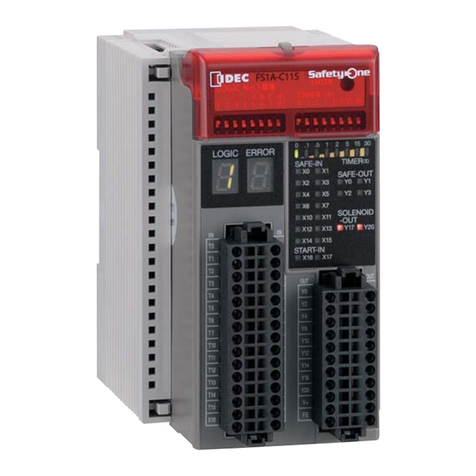
IDEC
IDEC FS1A-C11S User manual
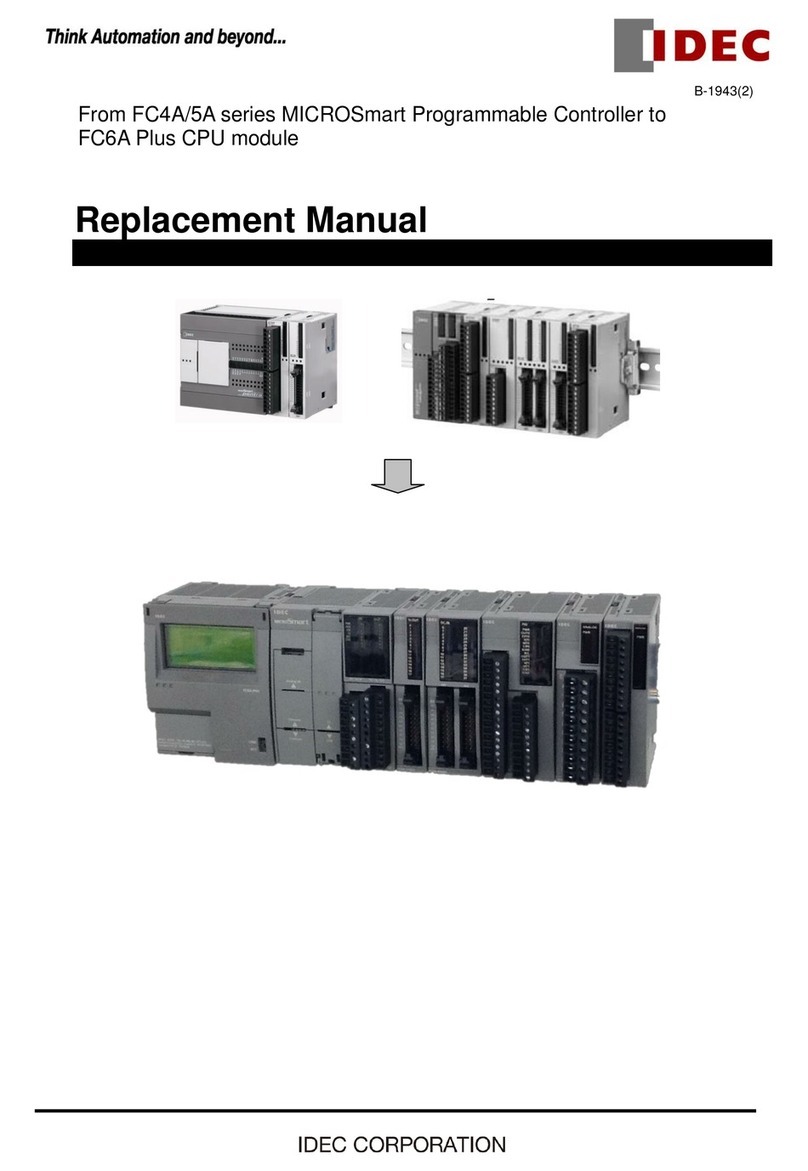
IDEC
IDEC MICROSmart FC4A Series Operating and safety instructions
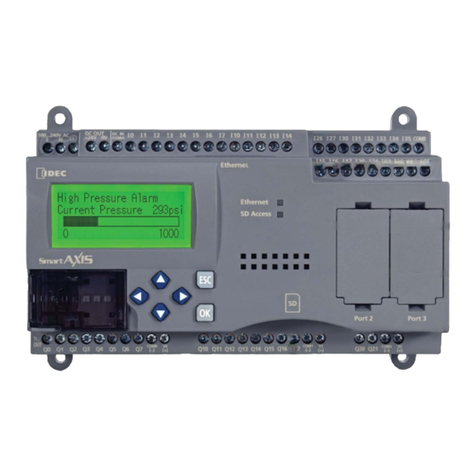
IDEC
IDEC SmartAXIS Touch FT1A Series User manual
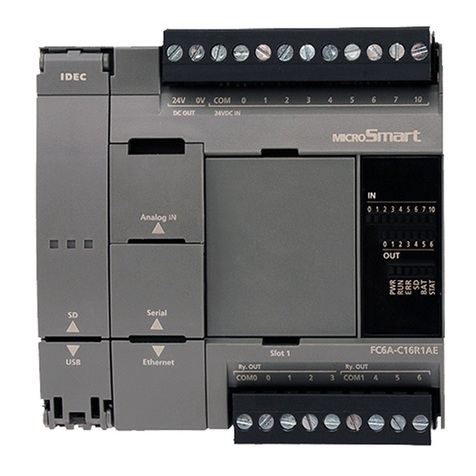
IDEC
IDEC MICROSmart FC6A Series Owner's manual
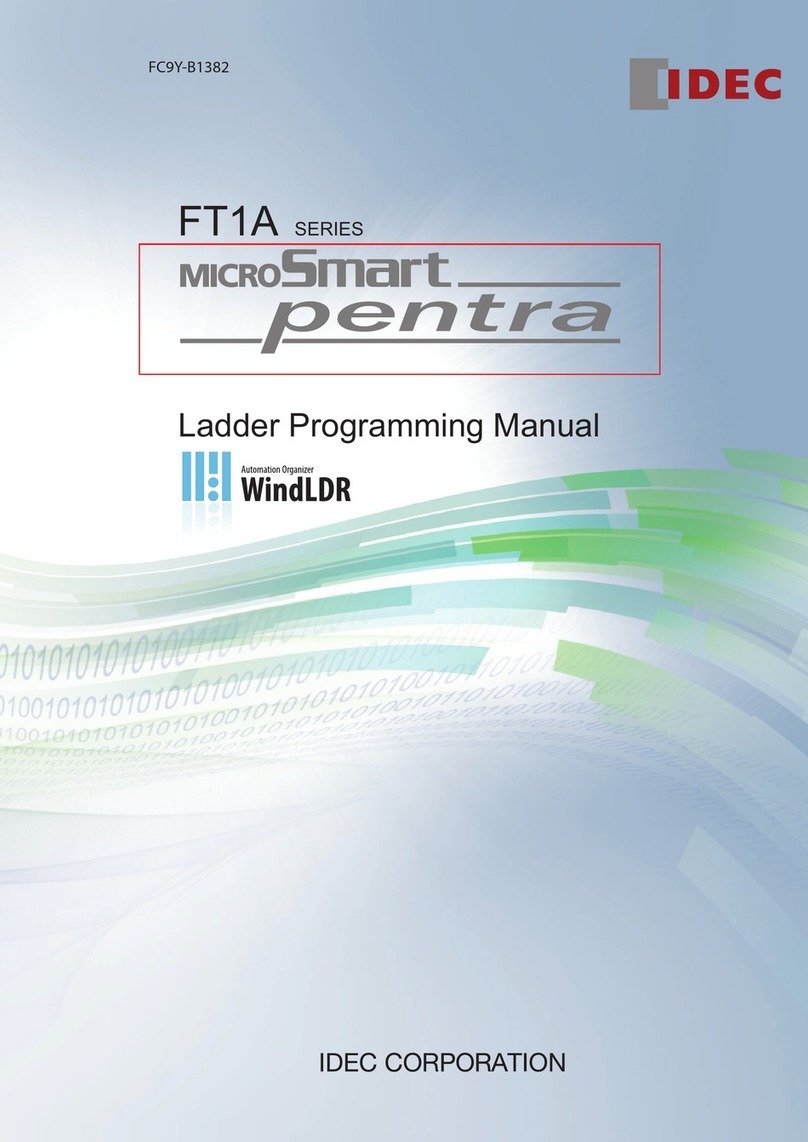
IDEC
IDEC microsmart pentra Owner's manual

IDEC
IDEC HS9Z-FL54 User manual
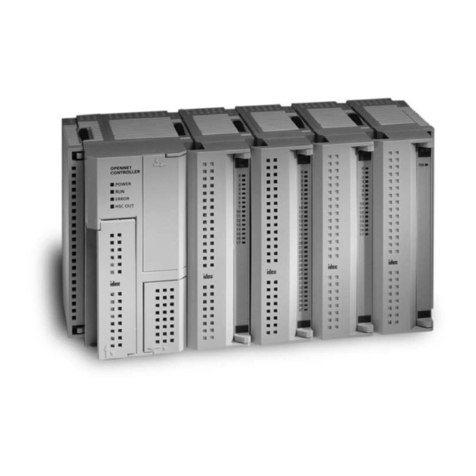
IDEC
IDEC OpenNet series User manual
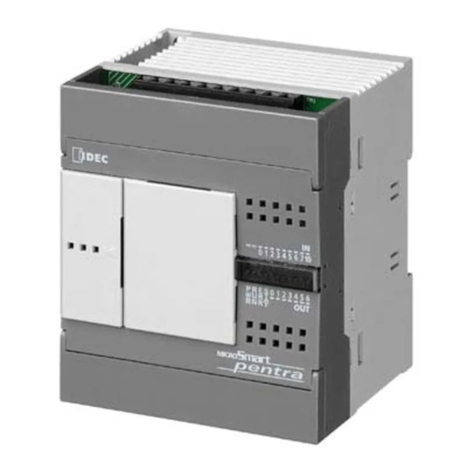
IDEC
IDEC MICROSmart FC5A Series User manual
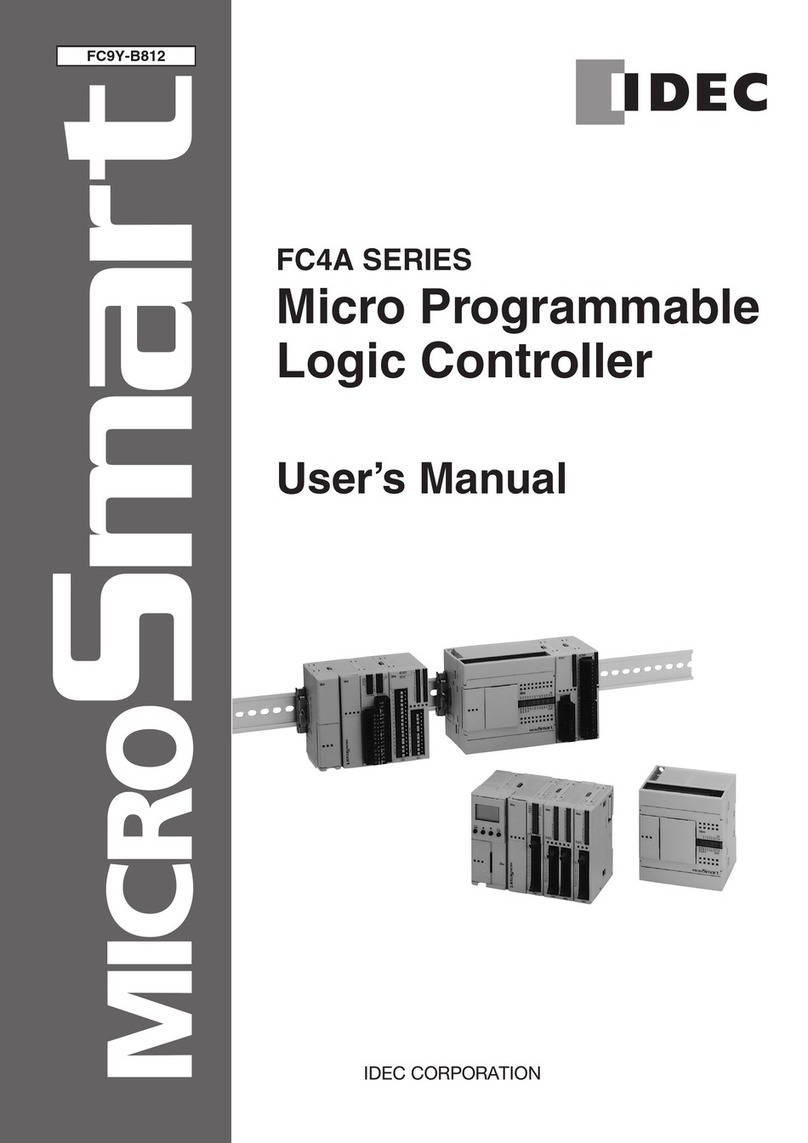
IDEC
IDEC FC4A-C10R2 User manual
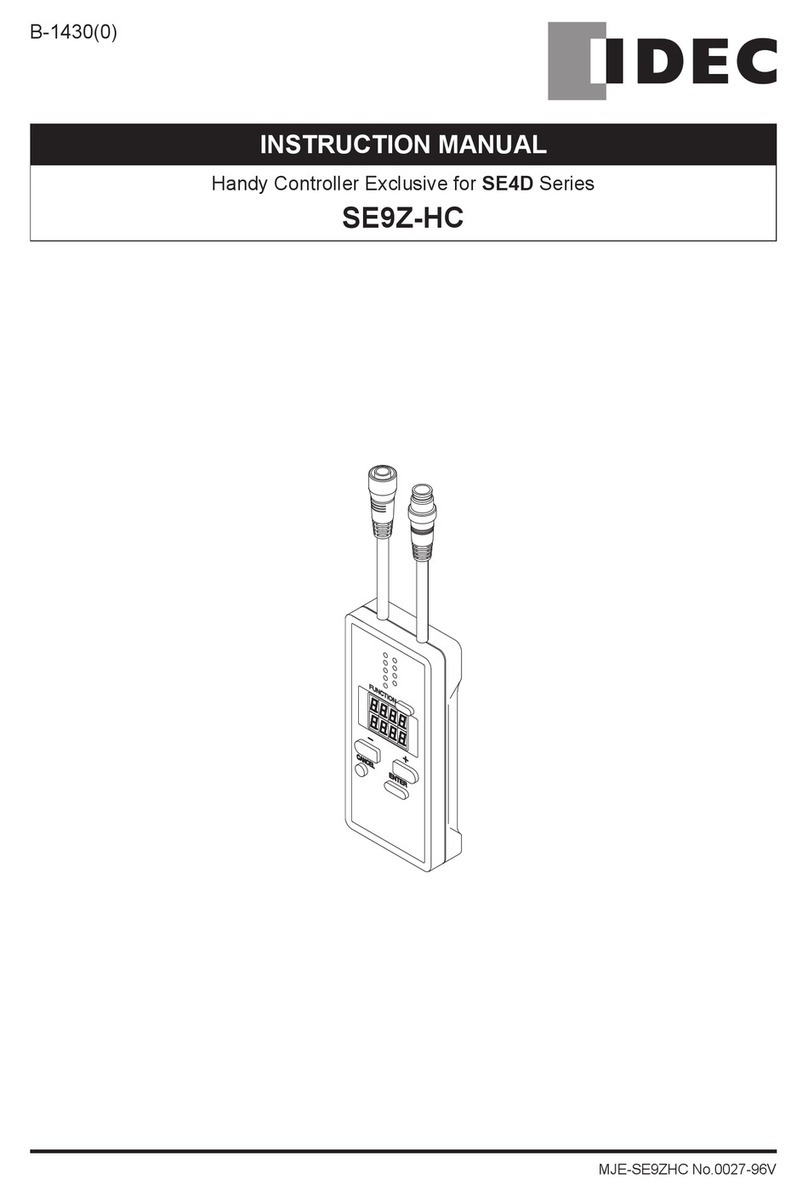
IDEC
IDEC SE9Z-HC User manual
